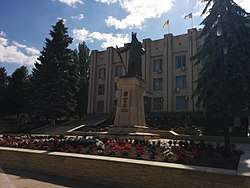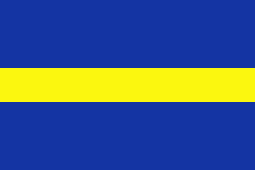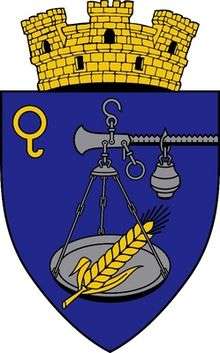Cimișlia
Cimișlia (Romanian pronunciation: [t͡ʃimiʃˈli.a]) is a city in the southern part of Moldova, on the banks of the Cogâlnic River. Cimişlia has a population of 12,800 according to a 2006 census. It is the administrative center of Cimișlia District. The city also administers three villages: Bogdanovca Nouă, Bogdanovca Veche and Dimitrovca.
Cimișlia | |
|---|---|
 | |
 Cimișlia Location within Moldova | |
| Coordinates: 46°30′N 28°48′E | |
| Country | Moldova |
| County | Cimișlia District |
| Government | |
| • Mayor | Sergiu Andronachi (ACUM, 2019- ) |
| Population | |
| • Total | 11,997 |
| Time zone | UTC+2 (EET) |
| • Summer (DST) | UTC+3 (EEST) |
| Area code(s) | +373 241 |
| Climate | Dfb |
History
The first written mention of Cimişlia dates from July 4, 1620, when the savant Vladimir Nicu explained that a local legend had given the town its name from an unknown origin word meaning "wealth". The priest Iacob Iusipescu, who made the first attempt at a written history of Cimişlia in 1874, explained that in fact it was a word of unknown origin, but cimiş was the name given to construction workers and bricklayers at that time, used by Romanian and Tatar alike.
The basis for the name might also lie in a bucolic legend of lovers, Cimiş şi Lia (Cimiş and Lia), for whom jewels appeared, birds sang, and springs appeared from the earth.
In fact, the reality of the locale is much harsher. Although in 1827 Cimişlia became an administrative center, many of its residents died of a plague and there was need of a special cemetery in the southeast part of town. Situated on the steppe of Budjak, by the Cogâlnic river, the city has often suffered from the droughts typical of the area. Dimitrie Cantemir, referring to this river in his work Descriptio Moldaviae, says "...one could say that it doesn't arise from a spring: it is only full after the rains of autumn and only then can one call it even a rivulet. All summer it is dry..." This would apply as well in our time.
In 1840 the locality received a statute as a market town. Its first school opened in 1844, and in 1885 the "hospital" of Zemstva (treating both people and animals). Between the two World Wars, (1918–1940), Cimişlia formed part of Tighina County or Ținutul Nistru; later, as part of the Soviet Union, it became a district center.
Location
Cimişlia is in Raionul Cimişlia, Moldova, on the banks of the river Cogâlnic.
It is located 73 km from the capital, Chişinău, at the intersection of several of the country's more important roads: it is on the route from Chişinău to Bolgrad or Giurgiuleşti, and is also on the Tiraspol – Leova road. It is 30 km from Comrat, 57 km from Căuşeni, 35 km from Hînceşti, 28 km from Basarabeasca, and 52 km from Leova, at latitude 46°30'10" N. longitude 28°48'30" E.
The city proper covers 2.084 km²; the associated area extends to 146.12 km², including 84.13 km² of agricultural land, including orchards and pasture.
Economy
The economy consists mainly of an agro-industrial complex with a well-developed network of manufacturing agricultural products, including meat, dairy, tree-fruit, and grain farming, as well as winemaking.
The Cimişlia railroad station, which takes advantage of the broad network of links toward the warehouses of the industrial and commercial companies of the city, is located in the village Mihailovka at a distance of 12 km.
Mineral resources
Fossil deposits on a territory of 2.56 km² in bluffs in the southeast of the city were discovered by I. Suhov in 1932 to contain bones, the remains of Hipparion fauna of the Turolian type, which were studied and described in numerous monographs published in Bucharest (I. Simionescu et al.) and Moscow (L. Gabunia). This deposit is of interest for geological correlations and paleogeographic reconstruction. It has been proposed that it become a scientific reserve.
Notable people
- Iurie Leancă
- Alexandru Leancă, actor
- Gheorghe Salaru
International relations
Twin towns – Sister cities
Cimişlia is twinned with:[2]







References
- Results of Population and Housing Census in the Republic of Moldova in 2014: "Characteristics - Population (population by communes, religion, citizenship)" (XLS). National Bureau of Statistics of the Republic of Moldova. 2017. Retrieved May 1, 2017.
- "Orașe înfrățite" (in Romanian). Primăria Orașului Cimișlia. Retrieved August 13, 2020.

